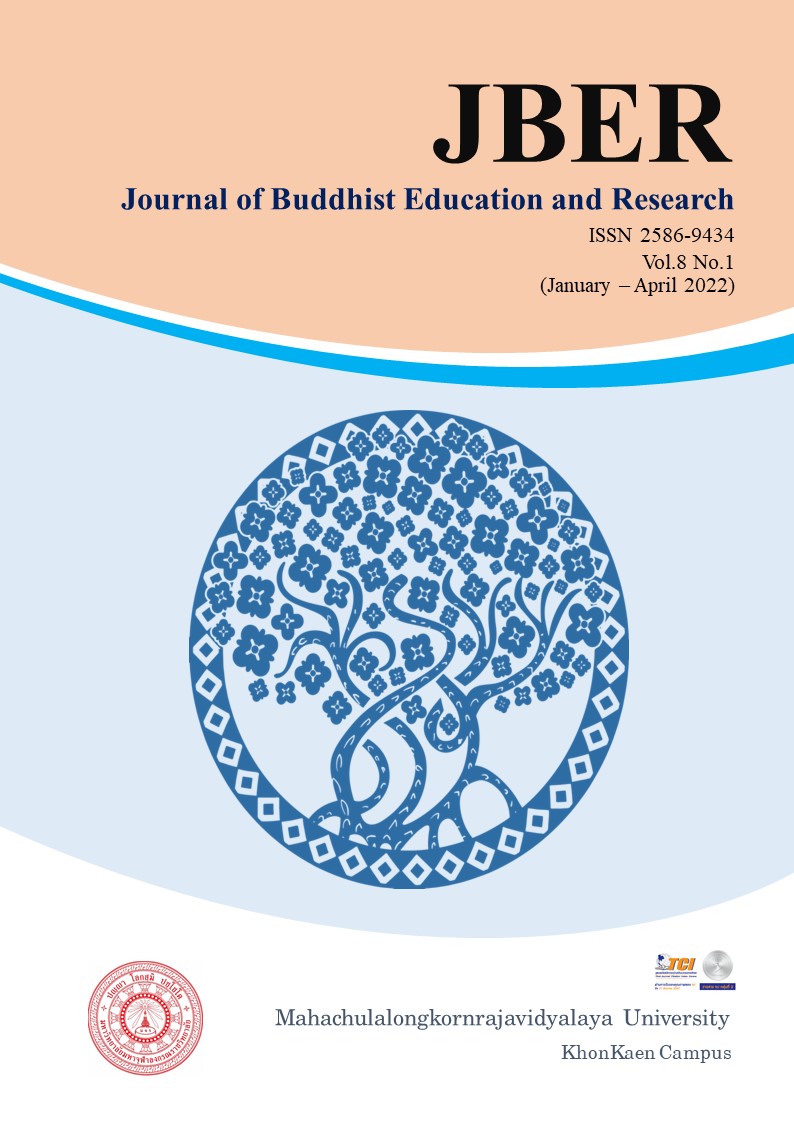THE EFFECT OF THE CLUB LEARNING ACTIVITIES ARRANGEMENT TO PREVENT THE EPIDEMICS BASED ON THE CHILD-TO-CHILD APPROACH WHICH INFLUENCES KNOWLEDHE AND AWARENESS ON PREPAREDNESS FOR AN EPIDEMIC OF LOWER SECONDARY STUDENTS
Keywords:
Club learning activities, Epidemics, Child-to-Child Approach, Awareness, PreparednessAbstract
The purpose of this study were 1) to compare pre- and post-activity knowledge regarding preparation for an epidemic obtained from the arrangement in club learning activities to prevent epidemics based on the child-to-child approach of lower secondary students; 2) to study post-activity awareness on preparation for an epidemic obtained from arrangement in club learning activities to prevent epidemics based on the child-to-child approach in middle school students. The sample groups were divided into 1) 20 older students from the nineth grade, and 2) 22 younger students from the seventh grade during the second semester in the academic year 2020 at Wat Suphan Phanom Thong School, Wang Thong District, Phitsanulok Province. All samples selected were by the simple random sampling method, and research tools employed included club activities for prevention of epidemics based on the child-to-child approach, knowledge tests concerning preparation for an epidemic and questionnaires concerning awareness on preparation for an epidemic. The statistics for data analysis were mean, standard deviation, and t-test.
The results can be summarised as follows:
- The post-activity knowledge of the older and younger students on the preparation for an epidemic obtained from the arrangement in club learning activities for prevention of epidemics based on the child-to-child approach in middle school students was at a higher level in comparison to pre-activity knowledge, that is, at a statistically significant level of .05.
- The overall post-activity awareness of older students on preparation for an epidemic obtained from the arrangement in club learning activities for prevention of epidemics based on the child-to-child approach in middle school students was at the highest level. Additionally, younger students on preparation for an epidemic obtained from the arrangement in club learning activities for prevention of epidemics based on the child-to-child approach in middle school students was at a high level.
References
จักรกฤษณ์ จันทะคุณ. (2558). การพัฒนาหลักสูตรเสริมสร้างจิตสำนึกในการเตรียมความพร้อมรับมือภัยพิบัติตามแนวคิดจิตตปัญญาศึกษา. วิทยานิพนธ์ปริญญาดุษฎีบัณฑิต. มหาวิทยาลัยนเรศวร.
_______. (2560). การพัฒนาหลักสูตรฝึกอบรมเตรียมความพร้อมรับมือน้ำท่วมตามแนวคิดพี่สอนน้องสำหรับนักเรียนในพื้นที่เสี่ยงภัย. วารสารวิชาการเครือข่ายบัณฑิตศึกษามหาวิทยาลัยราชภัฏภาคเหนือ มหาวิทยาลัยพะเยา, 7(12), 47-62.
ชัยวัฒน์ สุทธิรัตน์. (2561). 80 นวัตกรรมการจัดการเรียนรู้ที่เน้นผู้เรียนเป็นสำคัญ. (พิมพ์ครั้งที่ 8). นนทบุรี: พี บาลานซ์ดีไซด์แอนปริ้นติ้ง.
ดวงฤดี กิตติจารุดุลย์. (2557). ปัจจัยที่มีอิทธิพลต่อทัศนคติและความตระหนักด้านการบริหารจัดการความเสี่ยงกรณีศึกษา: บริษัทนำเข้าส่งออกแห่งหนึ่ง. การศึกษาค้นคว้าด้วยตนเองปริญญามหาบัณฑิต. มหาวิทยาลัยเนชั่น.
ทิศนา แขมมณี. (2544). ศาสตร์การสอนเพื่อการจัดกระบวนการเรียนรู้ที่มีประสิทธิภาพ. กรุงเทพฯ: บพิธการพิมพ์.
เทื้อน ทองแก้ว. (2563). การออกแบบการศึกษาในชีวิตวิถีใหม่: ผลกระทบจากการแพร่ระบาด COVID-19. วารสารคุรุสภาวิทยาจารย์, 1(2), 1-10.
บี บี ซี นิวซ์ (BBC NEWS). (2563). โคโรนา: มารู้จักไวรัสที่ทำให้เกิดโรคปอดอักเสบระบาดในจีน. สืบค้น 15 ธันวาคม 2563, จาก https://www.bbc.com/thai/thailand-51089461
_______. (2563). โควิด-19 ลำดับเหตุการณ์ แผนที่ อินโฟกราฟิก ยอดติดเชื้อ-เสียชีวิตในไทยและทั่วโลก. สืบค้น 15 ธันวาคม 2563,จาก https://www.bbc.com/thai/thailand-52090088
พรรณวดี ชัยกิจ, และสุมนทิพย์ จิตสว่าง. (2564). การแพร่กระจายของข่าวปลอมเกี่ยวกับการแพร่ระบาดของโควิด-19 และมาตรการป้องกันของไทย. วารสารรัชต์ภาคย์, 15(40), 15-32.
ศิริพันธุ์ ศิริพันธุ์ และยุพาวรรณ ศรีสวัสดิ์. (2554). การจัดการเรียนการสอนที่เน้นผู้เรียนเป็นสำคัญ: วิธีการสอนแบบใช้ปัญหาเป็นหลัก. วารสารมหาวิทยาลัยนราธิวาสราชนครินทร์, 3(1), 104-111.
สำนักงานกองทุนสนับสนุนการเสริมสร้างสุขภาพ. (2563). แนะหลัก 4 ต. สู้ภัยโควิด-19. สืบค้น 27 ธันวาคม 2563, จาก https://www.thaihealth.or.th/Content/51463-
Bosire Monari Mwebi. (2005). Narrative Inquiry into the Experiences of A Teacher and Eight Students Learning About HIV/AIDS through a Child-to-Child Curriculum Approach (Doctoral dissertation). Edmonton: University of Alberta.
Freeman, R., & Bunting, G. (2003). A child-to-child approach to promoting healthier snacking in primary school. Health Education, 17(103), 17-27.
Hawes, H. (1988). CHILD-TO-CHILD ANOTHER PATH TO LEARNING. Setzkasten Electronic Volker Stübing: Hamburg.
Wisner, B. (2006). Let our children teach Us! a review of the role of education and knowledge in disaster risk reduction. N.P.: n.p.





